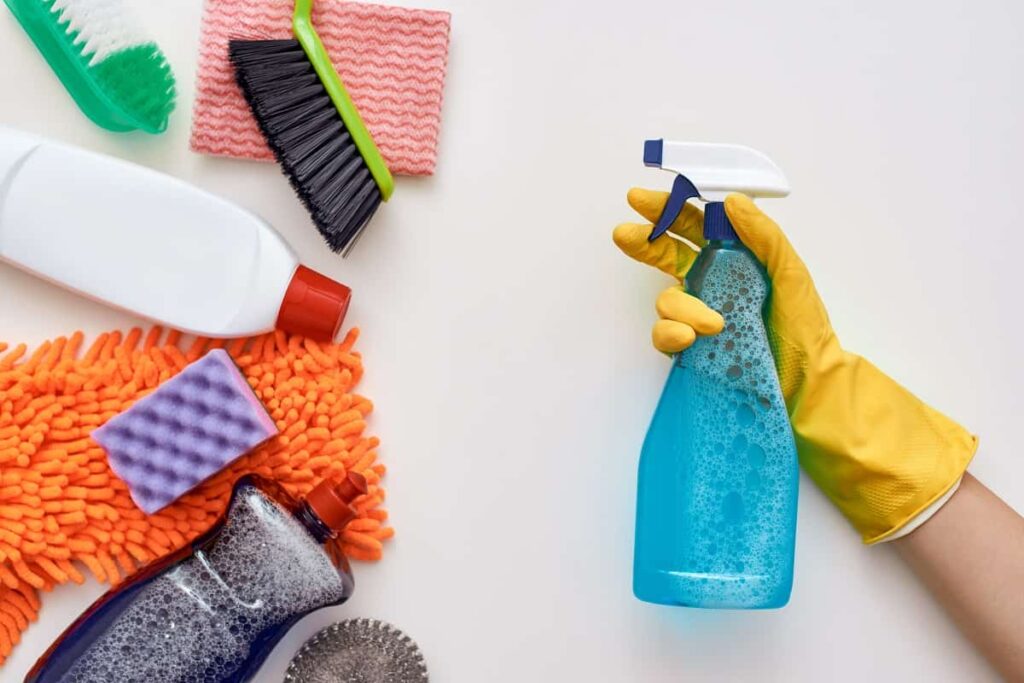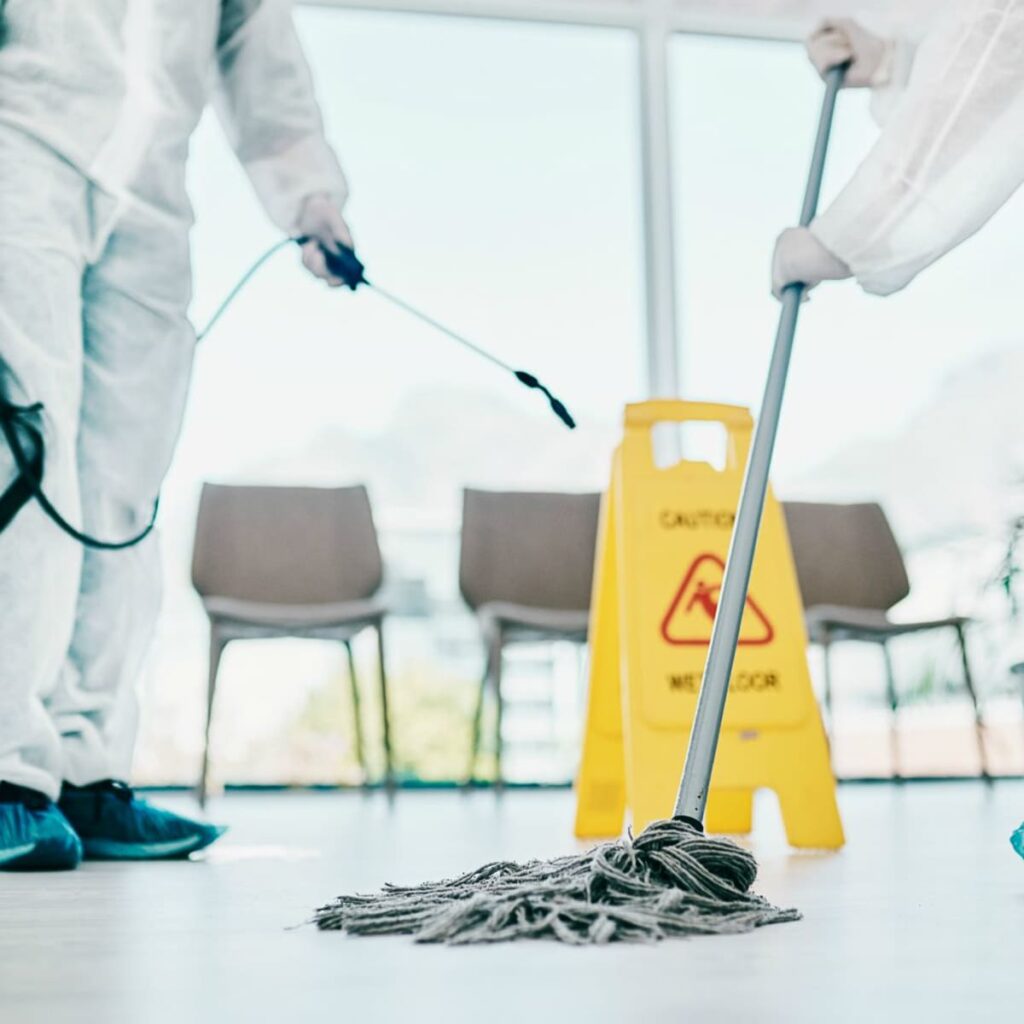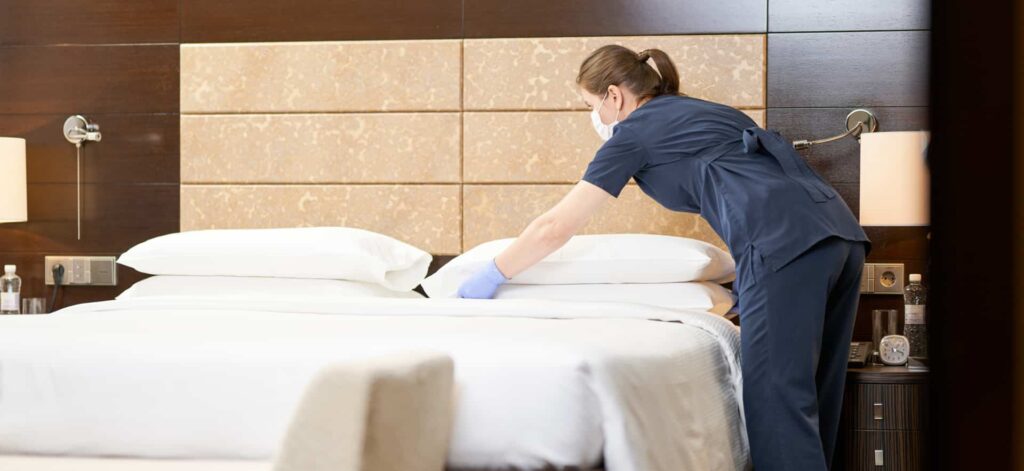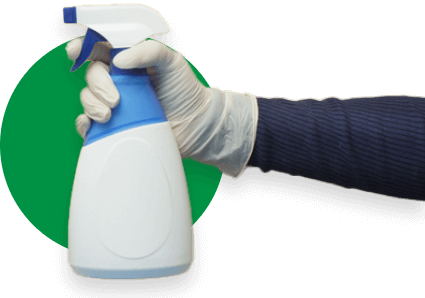The last few years should have reminded all of us of the importance of maintaining clean and healthy spaces. While COVID is not spreading as rampant as it was previously, it is still present. In turn, you can still get infected and suffer from symptoms. Therefore, it is best to understand proper cleaning, disinfecting, and sanitizing procedures.
Furthermore, you must maintain routine maintenance habits. By doing so, you can sustain safe public and private locations. As a result, you can help keep yourself and others healthy. In this article, we will explain everything you need to know about COVID-19 cleaning.
The Difference Between Cleaning, Disinfecting, and Sanitizing
It is important to understand the differences between cleaning, sanitizing, and disinfecting. While these terms may seem interchangeable, they are not. Each procedure has a varying degree of intensity. In turn, they will have different results. This is necessary to know as certain surfaces may require different tasks.
Furthermore, these differences can have long-lasting impacts. If a surface is not properly cleaned, sanitized, or disinfected, it may be unsafe for human contact. Unfortunately, this can lead to someone getting sick. So, for better public safety, fully understanding these terms can be quite helpful.

What is COVID Cleaning?
- To start, we will explain what COVID cleaning is. Cleaning surfaces means removing visible dirt and debris from them.
- Once you apply and use a cleaning solution, a surface will look spotless and safe. However, just because it looks safe doesn’t mean it is. In reality, these surfaces can still contain harmful viruses and bacteria. Therefore, simply cleaning is only suitable for low-contact surfaces and items.
- Typically, you will need soap and warm water to clean. In addition, there are cleaning solutions that do not contain harsh chemicals.
- Since this is a relatively easy task, cleaning should be done often. You can perform routine cleaning procedures a few times per week.
What is COVID Disinfecting?
- Moreover, COVID-19 disinfecting is the process of eliminating all harmful microorganisms from a surface. This is often confused with sterilizing, which will kill any microorganism, harmful or not.
- Unlike sterilizing, disinfecting is less intensive and can be done in everyday households. You will usually see sterilization in medical facilities.
- Now, what does disinfecting look like in the average household? Typically, it consists of disinfecting high-contact surfaces. This includes countertops, remote controls, sink handles, door handles, and light switches.
- These are all surfaces that people touch throughout the day. Therefore, they will begin to harbor significant amounts of harmful viruses and bacteria.
- Luckily, you can protect yourself with ease. There are plenty of disinfection solutions you can use. It is important to note that you should only use disinfection products that are EPA-approved.
What is COVID-19 sanitizing?
- The last term we must discuss is sanitizing. This is the least intensive out of the three.
- Generally, sanitizing means removing dirt to a “safe level.” Now, everyone can have a different opinion on what is considered “safe.” However, it is commonly accepted that “safe” means that you cannot get sick from interacting with that surface.
- Similar to disinfecting, you should clean before sanitizing. Afterward, you may use a low-level sanitizing solution. These typically contain less harsh chemicals than disinfectants. Therefore, they are less irritating when in contact. If you or someone else are sensitive to certain cleaning solutions, sanitizing can be a helpful alternative.
Cleaning Products That Eliminate COVID
With many cleaning products available, you can surely find items that can effectively eliminate COVID. However, not all cleaning products do. So, to save yourself time and money, it is helpful to know what types of products are effective and what are not.

Before purchasing any cleaning product, confirm that they are EPA-approved. If not, you may purchase something that is not effective or safe around contact. Items such as disinfectant wipes are effective against COVID. Furthermore, cleaning products that contain isopropyl alcohol will work as well. In certain instances, you can use hydrogen peroxide. However, if used improperly, it can cause skin irritation. Therefore, as with any cleaning product, you must wear appropriate safety equipment.
How Can I Sanitize My House Naturally After COVID?
Certain individuals may be sensitive to ingredients found in disinfection products. Thankfully, there are natural methods that are effective and do not use harsh or irritating chemicals.
- To start, you can use a common household item like vinegar. According to Aspen Clean, vinegar contains 5% acetic acid. This component helps kill around 80% of germs on surfaces. Although it is not completely effective, it can be a great start to the cleaning process.
- Afterward, you may want to use oxygen bleach. Unlike acidic vinegar, oxygen bleach is basic. Therefore, it can eliminate harmful microorganisms that vinegar cannot.
- Lastly, you can use cleaning products containing ethyl or isopropyl alcohol. Typically, it is best to use alcohol-based items with a 70% concentration. This is usually most effective.
It is important to note that while natural cleaning methods can be a great alternative, it may not be as effective as chemical-based products. A helpful solution for skin-sensitive individuals can be organic products. These typically have fewer chemical hazards.
Best Practices for COVID-19 Cleaning
The best practice for COVID-19 Cleaning is routine maintenance. Although the disease is not as omnipresent as it was previously, it does still exist. Furthermore, places with high movement and human interaction are susceptible to the risk of infection spreading. Therefore, you should uphold consistent cleaning and disinfectant procedures.
Dallas Janitorial offers a variety of effective and affordable cleaning services. Along with commercial cleaning services, we also provide intensive services such as disinfecting and deep cleaning. This will allow your space to remain safe and healthy. Furthermore, our team of experts understands appropriate cleaning procedures and practices. In turn, you are guaranteed efficient and thorough results.
How to Safely Clean Surfaces
To safely and effectively clean surfaces, you must follow proper guidelines. To start, you must ensure that cleaning products are suitable for those surfaces. Otherwise, it will not only be ineffective, but it may also damage the item. For most surfaces, you can use soap and warm water. This will remove all visible dirt and will improve the effectiveness of future disinfection.
When to Disinfect Your Home
Following cleaning, you must disinfect the surfaces in your home. As previously stated, sanitizing is not effective on its own. In addition, high-contact items require disinfection solutions as it is the only way to truly protect yourself. You should disinfect your home as soon as someone shows symptoms.
This can significantly reduce the spread of harmful microorganisms. Furthermore, you must do so once the individual fully recovers.
How to Disinfect Safely
Now that we have explained when to disinfect your home, we must discuss proper safety procedures. To begin with, you must fully read the instructions. This will provide appropriate handling guidelines. For example, you may need to wear safety equipment when using products that contain harsh chemicals.
In particular, you may be advised to wear disposable gloves and protective eye gear. Skin contact with certain disinfecting products can have negative effects, such as irritation or burns.

How to Clean and Disinfect Fabrics, Linen, and Clothing
Common items such as fabrics, linen, and clothing can be found in almost all households. Therefore, these products can harbor plenty of harmful microorganisms during times of COVID sickness. In turn, they must be properly cleaned and disinfected.
First, you should not whip any of these items in the air. While it is a common tactic used to remove dust, it can be dangerous. You may accidentally spread particles throughout the air. If you must do so, make sure you wear a mask.
Afterward, bring these items to your washing machine. Depending on the appliance, there may be a specific setting for fabrics and linen.
Finally, store your items in an appropriate setting. They must be kept in cool and dry places.
How to Disinfect a Bedroom
A bedroom can be a risky place if someone has COVID in your household. Once they are completely healthy, their bedroom must be deep cleaned.
- To start, any bedsheet, pillowcase, or blanket they use must be washed. Moreover, you may want to spray disinfectants after they dry. This will ensure that all harmful viruses and bacteria are eliminated.
- Then, you must vacuum their room, especially if they have carpet flooring.
- Afterward, all high-touch surfaces must be disinfected with an EPA-approved wipe or spray.
- Lastly, you should open up all windows and vents. This will improve air circulation and make the room feel fresh.
How to Clean and Disinfect a Bathroom after COVID Exposure
Like a bedroom, a bathroom can be a hotspot for viruses and bacteria.
- First, you must clean all surfaces with soap and warm water.
- Then, you should apply a disinfectant and allow proper contact time. These steps will maximize effectiveness.
- Once that is done, you should remove and wash all towels. Since they get wet, they hold harmful microorganisms for longer durations.
- Moreover, you should disinfect high-contact surfaces like sink handles, toilet flushes, and door knobs.
- Finally, you must mop the floor.
How to Clean Dishes Used By COVID Patients
The final risky place in the household is the kitchen.
In addition to high human movement and contact, the kitchen stores all of your food. Therefore, you must ensure that it is disinfected and safe. Also, individuals with COVID-19 will use dishes and eating utensils. If those items get mixed in, it can increase the transmission possibilities.
So, you must use proper dishwashing products and thoroughly apply them to all utensils. In addition, it may be wise to separate items that are used by COVID patients and items that are not.
Lastly, you should adhere to these cleaning procedures on your own. Yes, a professional company can effectively clean your kitchen. However, it is your responsibility to maintain a clean kitchen.
3 Things to Discuss With Your Cleaners Before Letting Them in Your House
Before you schedule an appointment with a cleaning company, you must ask and answer various questions. This will eliminate any confusion and help keep everyone safe.
- First, you must accurately state how many sick individuals there are, their bedrooms, and how long they have been sick.
- In addition, you should state what items and rooms require cleaning services.
- Lastly, you should confirm service fees. If it is out of your price range, you may want to contact a different cleaning company.

Frequently Asked Questions
COVID-19 rarely spreads through surfaces. So why are we still deep cleaning?
Yes, indeed, COVID-19 rarely spreads through surfaces as it is an airborne disease. So, you may think that deep cleaning is not necessary, as it will not directly prevent COVID. While that may be the case, deep cleaning is still an important task that should be completed routinely. To start, deep cleaning is necessary in all households. Over time, dirt can accumulate and become hard to remove.
By removing them, you better protect yourself and others from different non-COVID illnesses. Also, a properly cleaned home is more peaceful and pleasant to stay in. Studies show that cleaning your home can positively affect your mood.
How to disinfect a bed after being sick?
As previously stated, COVID-19 is an airborne illness that spreads through respiratory droplets. So, while it may not spread through individual surfaces, it can spread in a room. In particular, a bedroom is a prime spot for contamination. An individual with COVID will spend most of their time in bed. Therefore, once fully recovers, that bedroom and bed must be thoroughly disinfected. First, you must wear disposable gloves and disinfect all surfaces.
At the very least, it is an important precautionary step to take. Then, you spray disinfectant in the room. Be sure to wear a mask, as the fumes can be irritating. Afterward, you must remove all bedsheets, pillow covers, and blankets. Once that is done, put them in the wash for a complete cycle.
Lastly, you can vacuum the floor. This will all result in a properly cleaned and safe bedroom.
Are You Ready for Proper COVID Cleaning, Disinfecting, and Sanitizing?
At Dallas Janitorial, we understand the importance of maintaining clean public and private spaces. It is the first step in preventing yourself and others from becoming sick. So, if you are looking for professional cleaning services, Dallas Janitorial is the right company for you.
Our team of expert staff members are knowledgeable and experienced. Along with providing thorough cleaning services, they can offer advice on proper maintenance procedures. To learn more and schedule an appointment, please contact us at 214-778-3689. We look forward to hearing from you.







